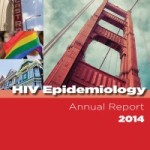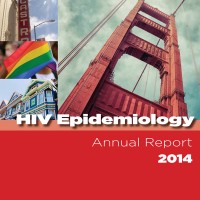Written by Liz Highleyman published on HepatitisandHIV.com 9/16/15
Newly diagnosed HIV infections and deaths among people living with HIV in San Francisco reached new lows in 2014, and the city continues to do a better job helping people get people tested and treated than the nation as a whole. But some notable disparities persist with regard to race, age, gender identity, and homelessness, according to the SF Department of Public Health’s latest HIV Epidemiology Annual Report.

“The 2014 report shows a decrease in newly diagnosed infections, among other successes in HIV prevention and care,” said Tracey Packer, SF DPH Director of Community Health Equity and Promotion. “This decrease is due to the success of new HIV prevention strategies developed in partnership with community members, HIV prevention and care organizations, and the health department.”
HIV Diagnoses and New Infections
The report, which covers data through the end of 2014, shows that the number of new HIV diagnoses in San Francisco fell by 18.5%, from 371 in 2013 to 302 in 2014 — the lowest number since the start of the epidemic.
Of the people diagnosed with HIV in 2014:
- 93% were non-transgender (cisgender) men, 5% were non-trans women, and 2% were transgender women; no newly diagnosed transgender men were reported.
- No children with HIV have been diagnosed in San Francisco since 2006.
- 45% of newly diagnosed people were white, 27% were Latino, 13% were Asian/Pacific Islanders, and 11% were African American.
- Most were in the 30-39 (30%) or 40-49 (24%) age groups, with 12% being age 18-24, 17% being 25-29, and 17% being over 50.
- 75% were men who have sex with men (MSM), 6% were people who inject drugs, 11% were both MSM and injection drug users, 3% were heterosexual, and 5% had other or unidentified risk factors.
- 11% were homeless.
People newly diagnosed with HIV in San Francisco were more likely than those nationwide to be men (93% vs 80%), to be white (45% vs 28%), and to have male-to-male sex as their transmission category (75% vs 52%), but less likely to have been infected via heterosexual sex (3% vs 11%).
The total number of new HIV infections, or incidence — estimated at 358 in 2014 — is higher than the number of newly diagnosed cases because not everyone is tested immediately. The 2014 incidence figure is down from 447 in 2013, and nearly matches the lowest-ever number, 356 in 2010.
The decline in new infections is thought to be due to a combination of factors including widespread testing, early antiretroviral treatment, and possibly early signs of the impact of pre-exposure prophylaxis, or PrEP.
In 2010 San Francisco was the first city to recommend antiretroviral therapy for everyone diagnosed with HIV regardless of CD4 T-cell count. Prompt treatment lowers the risk of illness and death, and people on treatment with an undetectable viral load have a near-zero risk of transmitting the virus.
The U.S. Food and Drug Administration approved Truvada (tenofovir/emtricitabine) for PrEP in July 2012, but adoption was initially slow. Interest began to rise more steeply after a May 2014 recommendation by the Centers for Disease Control and Prevention (CDC). But the level of PrEP uptake was likely not yet high enough to have had a substantial effect on last year’s HIV incidence figures.
“San Francisco is doing so many progressive things to reduce the number of new HIV diagnoses that it is hard to parse out the contributions of each,” iPrEx investigator Dave Glidden of UCSF said after a preview of the 2014 data was presented in July. “The scale-up of PrEP is comparatively recent and some of the work of my colleagues suggests it can play a big role in continuing to drive down the number of new HIV infections.”
Mortality and HIV Prevalence
The number of deaths due to all causes among HIV-positive people in the city decreased by 15.3%, from 209 in 2013 to 177 in 2014. Mortality declined among African American men and women with HIV, but remained higher than that of other racial/ethnic groups, all of which remained generally stable.
Over time, HIV- or AIDS-related deaths have become less common, falling from 68% of all deaths among people diagnosed during 2001-2004 to 44% among those diagnosed during 2009-2012. Conversely, other major causes of death have increased, including non-AIDS-related cancers (from 7% to 14%), drug overdose (from 3% to11%), heart disease (from 6% to 9%), and suicide (from 2% to 4%); deaths due to liver disease or viral hepatitis have remained stable at under 3%.
As deaths have declined thanks to effective treatment, the total number of people living with HIV, or prevalence, has continued to rise, reaching 15,979 in 2014. Of these, 9567 people had stage 3 HIV disease or AIDS.
Of the people living with HIV in 2014:
- 92% (total 14,722) were non-trans men, 6% (total 901) were non-trans women, and 2% (total 356) were transgender women; there is little data about trans men with HIV.
- 61% were white, 18% were Latino, 13% were African American (who make up just under 6% of the city’s population), and 6% were Asians/Pacific Islanders.
- A majority (58%) of people with HIV are now age 50 or older, with 27% being 40-49, 11% being 30-39, 3% being 25-29, and 1% or less being in younger age groups.
The geographic areas with the highest concentrations of HIV-positive people were the Castro, South of Market, the Tenderloin, and parts of the Western Addition and the Mission.
Continuum of Care
San Francisco continues to do a good job encouraging people at risk for HIV to get tested, and those living with HIV to access care and start treatment.
An estimated 93% of people with HIV in San Francisco know their status, compared with 87% nationwide. Among all people living with HIV — whether diagnosed or nor — the report estimates that 69% have received care and 60% have achieved viral suppression in San Francisco, compared with just 39% and 30%, respectively, nationwide.
Among San Franciscans newly diagnosed with HIV in 2013:
- 83% were linked to care within 3 months.
- 70% were retained in care 3 to 9 months later.
- 67% achieved undetectable viral load on antiretroviral therapy.
- 18% developed AIDS within 3 months of HIV diagnosis, indicating late diagnosis with advanced disease.
Women — both cisgender and transgender — were less likely to access HIV care and achieve viral suppression compared with men. African Americans were less likely to access care and have undetectable viral load than whites, while Latinos and Asian/Pacific Islanders were more likely. People in the 30-39 age group were more likely to be linked to care and have viral suppression than either older or younger people. People who inject drugs were the least likely to be promptly linked to care (56%) and be virally suppressed (40%).
Among HIV-positive people with available data from medical records, between 87% and 94% were estimated to be on antiretroviral therapy. Almost everyone (98%) with a CD4 T-cell count below 200 cells/mm3 was on ART, falling to 81% of those with more than 500 cells/mm3. Over time the median CD4 count at the time of HIV diagnosis and at ART initiation have risen, indicating more people are being reached before they develop advanced immune suppression.
The annual report shows that the city is making progress towards “Getting to Zero” — a collaborative effort to make San Francisco the first U.S. jurisdiction to achieve the UNAIDS goals of eliminating new HIV infections, HIV-related deaths, and HIV stigma, using a three-prong strategy of expanded access to PrEP, rapid access to antiretroviral therapy, and retention of HIV-positive people in care.
But other, less laudable, factors may also be contributing to the promising trends seen in the latest report. Due to San Francisco’s extremely high cost of housing, people with HIV are being displaced from the city, and some of the people most vulnerable to HIV infection can no longer afford to live there.
“These data show that San Francisco leads the nation in progress against HIV,” said Project Inform executive director Dana van Gorder. “They result from an intense emphasis on assuring high levels of HIV testing and linkage to care, encouraging early uptake of HIV treatment, and PrEP implementation — in addition to an extensive network of social services.”
“As well as we have done, San Francisco must address key challenges in order to get to zero,” he continued. “Young gay men of color, transgender women, and women of color need greater focus and strengthened services. And, once linked to care, we have to do a much better job of making sure that all people with HIV are supported to remain in care and treatment — these encouraging data suggest that we can succeed in doing so.”
9/16/15
Reference
San Francisco Department of Public Health, HIV Epidemiology Section. HIV Epidemiology Annual Report 2014. Published August 2015.
